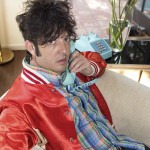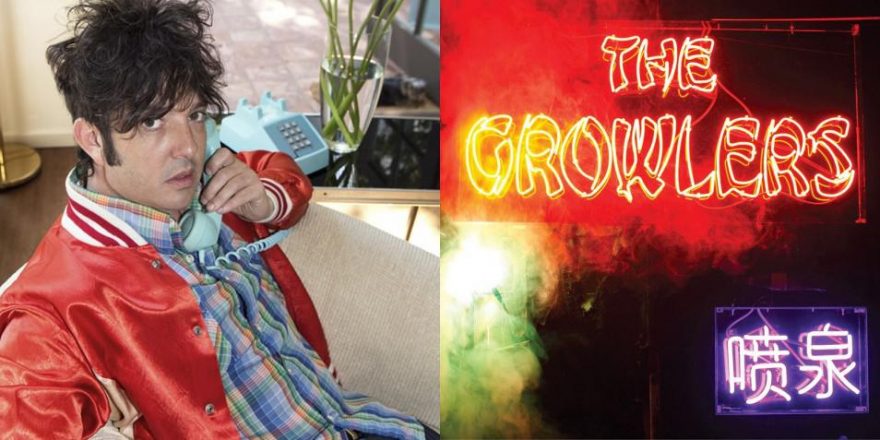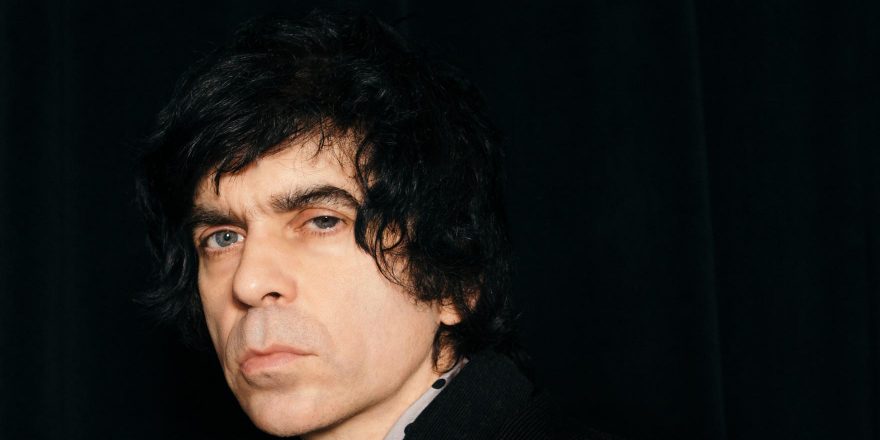Meditations on Crime is a multimedia project helmed by songwriter and producer Harper Simon. It comprises a book — featuring essays from artists and writers like Miranda July and Ben Okri, and visual art by the likes of Raymond Pettibon, Cindy Sherman, and Tracey Emin — and a record, featuring original music by Gang Gang Dance, Julia Holter, and many more. Here, Simon discusses the genesis of the project with his co-curator, the visual artist Jonah Freeman, and Nation of Ulysses’ Ian Svenonius, who contributed a song to the record. Meditations on Crime is available now.
— Annie Fell, Editor-in-chief, Talkhouse Music
Harper Simon: Boy, it’s so long ago now, but really [this project] started in 2016. It really came out of the the political circumstances of 2016; I felt that it was time to come up with some kind of project that addressed political concerns, probably for obvious reasons. I had never really dealt with trying to have political content in my writing, or doing any kind of collaborative project that was geared towards that.
I was really bewildered as to how to do it, and I felt that there was a kind of a bewilderment in the culture at large — everybody wanted to say something, but it was hard to know what to say. From an artist’s perspective, I thought it was a difficult time. A lot of the old forms that we’re accustomed to, like punk rock songs of protest, or films or works with overt political messages f hitting you over the head with an agenda, felt sort of trite and exhausted. I didn’t want to make a record of protest songs — that felt uncomfortable for me personally. So I came up with an idea that I would like to have a more curated collaborative project, that would have art and essays and music, and I would let creative people say what they wanted to say.
I had this title, Meditations on Crime, and I had run that by Jonah, and he liked the title and was encouraging about it. My idea for that was that it was a way to potentially get into some kind of political content, but not necessarily. I mean, all anyone had to do was sort of touch on crime or the history of crime, or anything having to do with this very vague umbrella of crime in any way they wanted to. And that could present politically, but then it could also go into any other number of areas. It could be about the more philosophical idea about crime or human nature — it could be crimes of the heart, it could be any kind of thing. And as more contributors came on, it became more abstract and less overtly political, although I’d say there still is quite a lot of political content in there.
Ian Svenonius: That’s really interesting for me, because I didn’t even know the genesis of the project when I was enlisted to be part of it. I didn’t even know that the impetus was the election, because I was thinking of it more like the nature of crime and crime changing according to context and social needs. You know what I mean? Like the way marijuana is now legal and encouraged — it’s basically compulsory to smoke marijuana, whereas 10 years ago your life could be ruined if you were caught with a joint — because marijuana, you know, is good for computer programming or whatever. So I had this whole other narrative going on around your project.
Jonah Freeman: I think that all that stuff is present in the project now as it evolved over many years. I think that that the notions you’re talking about are definitely there. The sort of the the elusiveness of what is a crime and [how] what is a crime for one person and one class of people isn’t a crime for others. And I think, for instance, the Ben Okri essay that kicks off the book sort of deals with that phenomenology of what is a crime.
Ian: I mean, it’s actually really interesting, because when a project takes a long time to come into fruition, then it changes so much according to the context. Especially now with the digital revolution, our reality basically changes minute to minute. We’re in this super accelerated situation that, I guess this is what the Industrial Revolution was like, but it took much longer to transform because everybody was getting kicked off the farm and all their morality was shifted, and everything they knew and believed in was suddenly made moot and pointless. And so we’re dealing with that kind of mass psychic and economic catastrophe right now, but it’s happening so quickly. And so 2016 to 2022 are such wildly different realities. I think about it a lot because now, ironically, things take so long to develop. Like, what if Sgt. Pepper’s took five years to come out?
Harper: I think about that all the time. Of course, there was the pandemic kind of sat right in the middle of this process as well. So that put the book back a couple of years.
Jonah: And that didn’t change that much over the pandemic.
Harper: But yeah, that’s true. In the first year or two, I was like, Oh, this is going to take a year or so, and then I’ll have my little contribution to whatever this political climate is right now. But of course, now as it comes out years later, there’s a different administration in place, although obviously many of the characters are still in play. And in a way, the criminality in our political dimension is—
Jonah: It’s probably more present than it was in 2016 — I mean, just the amount of bandwidth that it takes up in culture and news right now is sort of mind boggling. Who would have thought in 2016 what we’d be seeing right now with the amount of people who’ve been been charged with crimes, and the amount of crimes that have been alleged and the amount of crimes that people have gotten away with. It’s surrealism of the highest order.
What was nice about Meditations on Crime as a project taking so long is that you could adapt to these things happening. I just remember as we were going through it, things would happen and you’d be like, “Oh, this is the most timely thing for this project ever.” And then one after another, you could kind of start to expand the scope of it, which did make it take longer, but also allowed it to have this kind of breadth of a real spectrum of crime as opposed to just a little meditation. It’s a big meditation.
Ian: But what’s also interesting is, to me, the book really falls right into that ‘50s beatnik thing, of like Paul Bowles and Genet and this kind of celebration of outsiders.There’s that whole aspect that art used to be almost synonymous with — the beatniks lived outside of society, and that’s what artists used to be: the ultimate outsiders. Since 2016, the role of art in society is also completely different. I feel like it’s more institutional and more respectable than ever.
Jonah: Absolutely. Less risky, less of a crime.
Ian: Yeah. There’s really no question of doing anything outside of the lines now. Like, anything with any nuance has to be smoothed out.
Harper: I think that’s true. And I think this project probably is in line with that history of artists more as misfits and outsiders, in terms of who was curated. And maybe it’s just more in terms of who I’ve curated into my life, or the kind of work I like, which is pretty noncommercial and countercultural always. Jonah came on to really help me and be essential in the curation of the art of the book. I really needed Jonah to help expand the visual content of the book and bring in more artists that he thought were fitting to the tone of the project, so I could focus more on making the album and curating the writers.
But my idea was, I kept thinking of myself as a 13 year old, when I discovered subversive projects and movements that were really exciting to me — just that feeling of being a young kid and finding your way to a kind of punk rock record store or, even in the video stores, and that process of finding subversive counterculture and feeling inspired by that. I imagined creating something that might hit a young person in the same way, if they ever found this project — which maybe they won’t, because maybe the artists involved are really from another generation. Or maybe they will. I don’t know.
Ian: So you’ve got the visual, you’ve got the audio, you’ve got the the writing — did you think about doing any cinematic? I know that you were talking about making a film.
Harper: Yeah, Jonah and I are working on a short film, so there’s will be a short film component to it.
Ian: So it’s really like a gesamtkunstwerk — it’s operatic in its scope.
Harper: I mean, partly in the beginning, I thought I was just looking to do an album of co-writes with people who I, like, dug their work and thought it would be fun to write a song with. And then I was like, Well, I should do a record and a book — maybe the book will come with the record and I can make a beautiful object. Anyway, over these years, one person led to another person and then it started to have shape itself. And then it was like, OK, now the tone of the contributors is this. We should have this kind of person, we’re missing that kind of person, or that other kind of artist is not really going to fit in here.
One of the things that’s fun about it for me is that it it allows me to sort of have a presence in some different worlds that you don’t get to participate in, necessarily, when you stay just in the music world. I was inspired by the MOCA Book Fair — the Printed Matter stuff, and that world of art books. And I thought it would be fun to have some presence in the film world, and then there would be a literary component and all these worlds that we sort of get to move in to some degree.
I had a few [visual artists on board] before I enlisted Jonah — I had Cindy Sherman, I had Tracey Emin, and a couple others. And Jonah was going to be a contributor, but then he brought in so many great artists.
Jonah: Yeah, you asked me to be a contributor right in the beginning, I think, in 2016. You had a short PDF of different images that were kind of inspirations, and the whole thing was great, so I, of course, agreed to be involved. And then shortly thereafter, Harper asked me to help curate the visual portion. I had a list of artists that was extraordinarily long, and was dead people and young people and people of all generations and whatnot. But we did ultimately eliminate the people who couldn’t actively contribute and think about the subject. So then I just started to think about people I knew to begin with whose work kind of dealt with crime, and that became the kind of unraveling of the very narrow notion of crime in my mind.
I would talk to artists — say someone like Mark Flood, whose work relates to crime in so many different ways. Even his art has been in crime scenes, as a matter of fact. But then he just had these paintings of corporate logos that have been degraded through digital glitches and whatnot, and so then that component of corporate crime — which would be a counterpoint to someone like Raymond Pettibon, who would dealing with very mainstream notions of crime, in that he was dealing with iconic figures like John Dillinger. And then you had people like Gibb Slife, who actually made new work for the project, this whole series of signatures of serial killers. And then you had someone like Davina Semo, who doesn’t really deal with narrative content in her work at all; it’s all kind of about materiality in a sense, but her chain sculptures sort of hint to this sense of bondage. So you could have these associative art elements, and then it just went on and on like that.
The great thing about curating is, as an artist, you’re kind of always locked in your own narrow universe of what’s going on inside your head, of what you’re going to make, and it becomes very solipsistic. So to expand out and talk to people and engage with their work can bring a lot to your life. It was a good process; I just had conversations with every artist about what they what they thought about crime and how their they thought their work fit into it, and everybody was different. And I think that shows through in the book. It’s a full spectrum.
Harper: Yeah. And with the essays, it was similar. I mean, I had someone like Janine Di Giovanni, who’s a famous war correspondent, and she wrote a great, powerful piece on war crimes. And that could go to something quite light, like Miranda July’s essay on when she was a teenage shoplifter. To call something Meditations on Crime is absurd, because it’s not like you can get to the end of the project.
Jonah: “That’s it, we’ve nailed it.” [Laughs.]
Harper: “We covered crime. Moving on.” I mean, you could spend your entire life — it’s just too vast, it’s too intrinsically woven into the nature of humanity, and the unfolding of the human drama and history of politics and power. So it’s an absurd title, in a way.
Jonah: Yeah. But I really think it lived up to it. I mean, maybe it needed to take the six years to come out in order to be a real meditation on crime, as opposed to just a quick little thing. I was thinking about the other day that it’s kind of a work of pop art, in a way — these big general themes, like crime and sex, are really what pop art is made of.
Ian: And Shakespeare.
Jonah: Yeah, totally. And so it’s not super niche. It’s just something that everybody can dig into.







